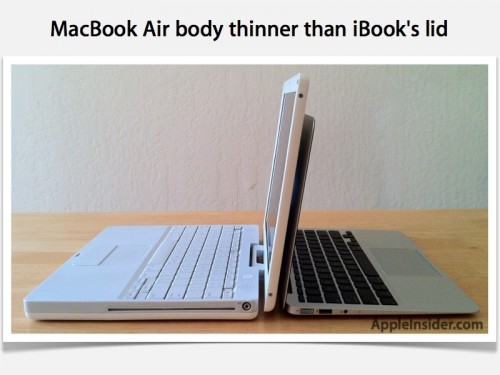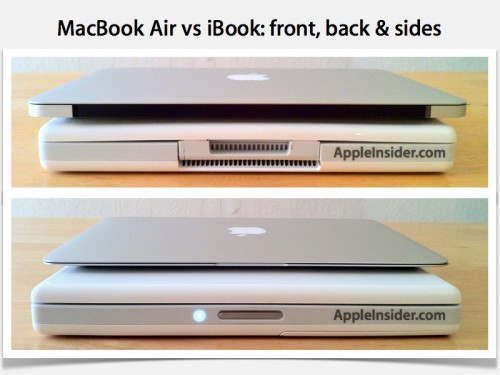Five years of Apple: 2005 iBook to 2010 MacBook Air
Five years ago, Apple was selling the iBook G4 which evolved from the original iMac. The iBook released mid 2005 got 1.33 or 1.42 GHz PowerPC G4 processors, 12.1 inch or 14.1 inch display, weighted 4.9 lbs (2.2 kg) (smaller version) or 5.9 lbs (2.7 kg) (larger version). Both models had 1024x768 screen resolution and were 1.35 inches (3.4 cm) thick.
Apple's latest laptop, the 11.6 inch MacBook Air, is equipped with 1.4 or 1.6GHz Intel Core 2 Duo, weighs just 2.3 lbs (1.04 kg) and is only 0.68 inches (1.7 cm) at its thickest.
Of course, design of Apple’s laptops also changed. In 90s Apple led the market with integrated trackballs, trackpads, now the company uses across its current MacBook lineup multitouch trackpads, backlit keyboards, and ambient light sensors to adjust the display.
Apple was one of the first companies which began use Lithium Ion batteries, USB, Gigabit Ethernet, 802.11 wireless networking, optical digital audio input and outputs, and standardized Mini DisplayPort video output. This year company decided to replace hard disk drives with solid state drives. Apple also dropped separate buttons from its trackpads, making the entire surface a tactile button.
Beginning with the original MacBook Air in 2008, Apple pioneered an entirely new construction method for notebooks using aluminum unibody frames. More noteworthy advancements over the past five years include FaceTime camera and the new DisplayPort standard, which supports resolution of 2560x1600. The 2005 iBook could only officially support 1024x768.
Of course, Apple’s other mobile devices, like the iPad and iPhone, couldn’t help influencing current generation of MacBook Air. For example, display construction technologies related to the iPhone and iPad allow the new MacBook Air screen lid to be extremely thin.
Follow us on :




 Leave a comment
Leave a comment